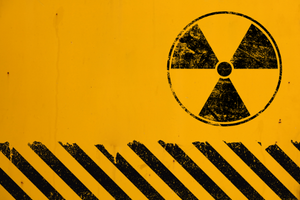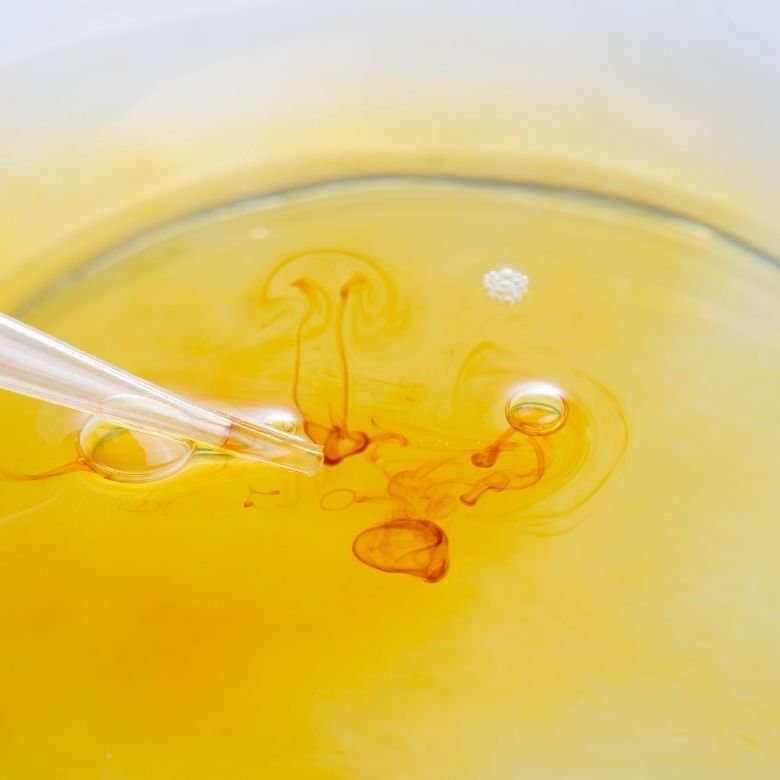The structure and composition of the fluid was first proposed in the 19th century by the French physician Jean Auguste Lugol. It was originally intended for the treatment of tuberculosis, but these attempts were unsuccessful. The world heard about Lugol’s solution again in 1986 with the explosion at the Chernobyl Nuclear Power Plant. Lugol’s solution was then administered to the population to prevent the absorption of the radioactive isotope of iodine. In such cases, the medication saturates the thyroid gland with iodine, protecting it from damage and reducing the risk of thyroid cancer. Today, Lugol’s solution has several, mainly medical, applications. It is worth learning more about the properties of this preparation and answering the question: can it really protect us?

Side effects
Lugol’s solution, due to its antiseptic effect, is mainly used for disinfecting the skin, in the form of an aqueous iodine solution for gargling, and also consumed for the treatment of the thyroid gland. As with any medicine, inappropriate ingestion of Lugol’s solution carries the risk of serious health and life dangers, especially for children. Without the explicit recommendation of a doctor, you should definitely not prepare this formulation yourself, let alone take it.
Prophylactic intake of Lugol’s solution is harmful and can have very serious health consequences!
The acute toxicity of Lugol’s solution is mainly related to the iodine content, although the high concentration of potassium (from potassium iodide, KI) can lead to extreme irritation of the mucous membranes. Patients found to have ingested too much iodine may suffer from metabolic acidosis, renal failure, hypotension and even circulatory collapse as a result. There is a particular danger if a person with hypothyroidism or hyperthyroidism overuses Lugol’s solution. Let us not forget that hyperthyroidism, for example, can even be life-threatening for cardiovascular patients, as there is a high probability of heart failure. Thyrotoxicosis, an excess of thyroid hormones in the body that causes heart rhythm disturbances, is also dangerous. Other symptoms and effects of unconsidered intake include:
- cold sweats,
- diarrhoea,
- high fever,
- dyspnoea,
- development of Hashimoto’s disease,
- dermatitis,
- iodine acne,
- bothersome allergic reactions,
- swollen lymph nodes.
People who should be particularly wary of prophylactic intake of the solution without explicit instruction from a specialist are primarily patients suffering from diseases such as hyperthyroidism, pulmonary tuberculosis or iodine hypersensitivity. Pregnant and breastfeeding women should also be included in this group.
What is Lugol’s solution?
Lugol’s solution is an aqueous solution of iodine. Crystalline iodine is very difficult to dissolve in distilled water. As an element, it is hydrophobic, whereas water is hydrophilic. Thus, a kind of “link” between the two components is needed to enable them to be combined. Potassium iodide is that link. It makes it possible to dissolve iodine in water by means of a phenomenon called hydrotrope solubilisation. Iodide ions (derived from potassium iodide) combine with iodine molecules to form tri-iodide ions I3–. They have a negative charge and therefore become polar and eagerly bond with water molecules.
Lugol’s solution in standard concentration has the following composition: 100 mg/ml potassium iodide (KI) and 50 mg/ml iodine (I2). By varying the proportions, it is possible to obtain iodine solutions of the desired concentrations, usually 1%, 2% or 5%. Lugol’s solution must categorically not be confused with iodine. Iodine is an alcoholic solution of iodine and potassium iodide. It is used exclusively for wound disinfection. Its consumption causes severe gastrointestinal discomfort as well as serious allergic reactions.
Application of Lugol’s solution:
- reduces the vessels of the thyroid gland, hence its application to reduce blood loss during thyroid surgery;
- temporarily inhibits the synthesis and secretion of thyroid hormones, so it can be used to treat hypothyroidism and reduce the risk of thyroid dysfunction after surgery;
- blocks the uptake of radioactive isotopes by the thyroid gland, thus reducing the risk of thyroid cancer, hence the use in radiation emergencies or therapeutic/diagnostic exposure to radioactive iodine;
- Lugol’s solution is also approved for topical use as an antiseptic;
- in addition to its medical use, Lugol’s solution can be successfully used to detect starch in food products. In the presence of starch, the liquid changes its colour to dark blue.

What do table salt and Lugol’s solution have in common?
Elemental iodine is the link between table salt and Lugol’s solution. Almost every packet of table salt is labelled “iodised.” What does it mean? The term “iodised” refers to table salt to which iodine, an important micronutrient for our body, has been added. The daily requirement for iodine is around 200 μg. In many regions, food and water are so poor in iodine that the natural supply of this element to the body becomes problematic.
Although elemental iodine was only isolated in the 19th century, the antimicrobial properties of iodine-containing substances, especially algae, have long been known and used: for example, Aristotle’s pupil Theophrastus described the pain relief enabled by marine algae when sunburned. Over the decades, iodine has found medical application in several important areas. Iodine plays a significant role in our bodies. This element is a powerful antioxidant. Iodine is needed for the synthesis of the thyroid hormones, thyroxine T4 and triiodothyronine T3. Indirectly, it is essential for the proper functioning of the entire body. It plays an important role in maintaining normal cognitive functions, as well as in the proper functioning of the nervous system. Thanks to its appropriate levels, energy metabolism takes place in the body. Additionally, iodine helps to keep our skin looking and feeling great. The recommended daily intake of iodine in adults is 200 μg per day, except for pregnant and lactating women who have a higher iodine requirement. The primary source of this element is the diet, where iodine intake comes mainly from dairy products, cereals and iodised salt.
The Chernobyl disaster and Lugol’s solution
On 26 April 1986, there was an accident at the Chernobyl nuclear power plant in Ukraine. The reactor explosion led directly to the contamination of a large part of the territory of present-day Ukraine and Belarus. The radioactive cloud spread over practically the whole of Europe. Radioactive substances also spread to countries far away from Ukraine, such as Greece and Italy. At present, the reactor of the fourth unit is covered by a specially constructed containment shell.
As a direct result of the Chernobyl disaster and the rescue operation carried out at the time, 31 people died. Around 600,000 people from all over the world have been exposed to an increased dose of radiation, equivalent to two X-rays. As a result of radioactive contamination, the incidence of cancer has increased significantly in people who are heavily irradiated.
In Poland, the disaster was announced on 28 April. The very next day, the recommendation to drink Lugol’s solution was introduced. That was probably the first time most Poles had heard of it. This was a nationwide prevention campaign, which mainly targeted children and young people. Why was this recommendation introduced? To prevent the possible effects of radioactive contamination. Attention was drawn to the danger of the radioactive isotope of iodine131I. It could get into the milk and then accumulate in the babies’ thyroid glands. The purpose of Lugol’s solution was to saturate the thyroid gland with iodine and thus prevent the radioactive isotope of iodine from co-forming thyroid hormones.

Antiseptic effect
The antiseptic function of Lugol’s solution is well known. As a bactericide, iodine penetrates bacterial cell walls, and although its exact mechanism of killing is uncertain due to the extensive reactivity of halogens, it probably involves delaying bacterial protein synthesis, disrupting electron transport, denaturing DNA or destabilising the membrane. In addition to oxidising reactive parts on cell surfaces, iodine poisons the electron transport chain that is used by all living cells to generate energy. Although there is a way for a cell to develop immunity by preventing contact with extracellular iodine, it is difficult to imagine what form such a mutation could take. To develop resistance to electron transport, a cell would have to develop properties that do not fit the definition of living organisms.
Lugol’s solution contains a large amount of free molecular iodine and is therefore highly effective. So how to use it properly? Simply soak a cotton wad in the solution and cleanse the skin. It should be used with precaution due to the risk of discolouration and toxicity. It should also not be applied to open wounds, as strong iodine solutions can cause unpleasant stinging and allergic skin reactions.
The toxicity of Lugol’s solution required the development of alternative, less irritating solutions that would maintain high antimicrobial activity. In addition to problems with local toxicity, the use of iodine as a beneficial antiseptic has always been hampered by chemical instability and poor water solubility. Today, pure aqueous and alcoholic solutions of iodine have largely been replaced by iodophor solutions that use organic complexing agents to achieve specific effects.
Treatment of hypothyroidism
Thyroid diseases are related to disorders of the endocrine glands. They develop slowly, and the symptoms of the disorder are often not clear, so they are usually ignored. Thyroid dysfunction affects women far more often than men. Failure to recognise and consequently treat usually leads to a number of health complications. One of the thyroid disorders, the so-called hypothyroidism, is caused by iodine deficiency. This element can be supplied internally to the body by drinking Lugol’s solution, but only with the explicit direction of a doctor. Never on your own.
In diseases of the thyroid gland, iodine is essential for the production of thyroid hormones. For our thyroid gland to function properly, the daily requirement of iodine is approximately 150 μg. It should be dosed with food. Iodine affects the hyperactive thyroid by inhibiting the hydrolysis of thyroglobulin and inhibiting the action of thyrotropin hormone (TSH). In medicine, an aqueous solution of iodine in potassium iodide, or Lugol’s solution, is most commonly used.
When necessary, the thyroid is given surgical treatment. The procedure, called a strumectomy, involves removing the entire gland or leaving a section of the active thyroid gland. In the period of six weeks before the planned operation, i.e. in the so-called preparatory period, the patient is given thyreostatics and additionally, one week before the operation, the patient receives Lugol’s solution to drink. The initial dosage is 5 drops, three times a day, and then the dosage is gradually increased to 15 drops.
Wolff-Chaikoff effect
The Wolff-Chaikoff effect is an autoregulatory phenomenon in which large amounts of absorbed iodine inhibit thyroid hormone synthesis in follicular cells, independent of serum thyroid hormone (TSH) levels. The Wolff-Chaikoff effect is thought to be transient, with the thyroid returning to near normal hormone synthesis within 26-50 hours. It provides temporary protection against the thyroid gland synthesising excessive amounts of thyroid hormones in cases of iodine excess. After the Chernobyl disaster, the consumption of Lugol’s solution was recommended precisely to induce the Wolff-Chaikoff effect. This effect was first observed in 1948 by Jan Wolff and Israel Chaikoff, who observed a decrease in organic iodine binding when increasing plasma iodide concentrations.

FAQ
- How to prepare Lugol’s solution yourself?
In order to make Lugol’s solution yourself in a certain concentration (usually 1%, 2% and 5%), you need crystalline iodine, potassium iodide and distilled water. The ingredients are combined in the appropriate proportions. Avoid doing this on your own at home. The mishandling of chemical reagents leads to health and even life risks.
- How to use Lugol’s solution correctly?
If you want to use Lugol’s solution as an antiseptic, soak a cotton wad in it and wash the intact skin. To gargle the throat or tonsils, use a solution of a few drops of the solution in 100 ml of boiled water.
- Where can I buy Lugol’s solution?
The best place to buy Lugol’s solution is a pharmacy, a place dedicated to the sale of this type of preparation. Never purchase products from unverified or suspicious websites. It’s best to consult your doctor or pharmacist.
- How many drops of Lugol’s solution should I use?
How to drink Lugol’s solution? When we want to prepare an aqueous solution of Lugol’s solution for gargling, it is best to use 10 drops per 200 ml of lukewarm boiled water. This preparation can be used to gargle several times a day.
- How much does Lugol’s solution cost?
The price of the ready-made preparation varies, depending on the place of purchase, from several to a dozen or so zlotys [PLN] per package. The product can usually be purchased in bottles ranging from 50 ml to 100 ml.
- Is Lugol’s solution available on prescription?
Lugol’s solution is available in pharmacies without a prescription. At the same time, it is not intended for consumption! The preparation, which can be purchased without a prescription, is unpurified and can only be used externally. When the doctor recommends the consumption of the solution, we go with the prescription to the pharmacy, where the pharmacists prepare the formulation.
